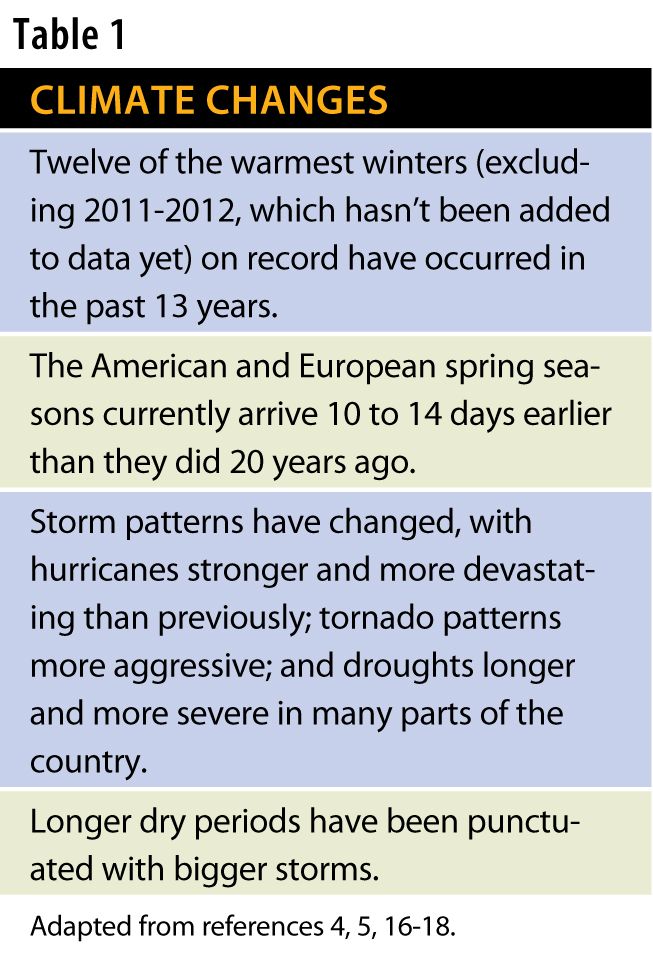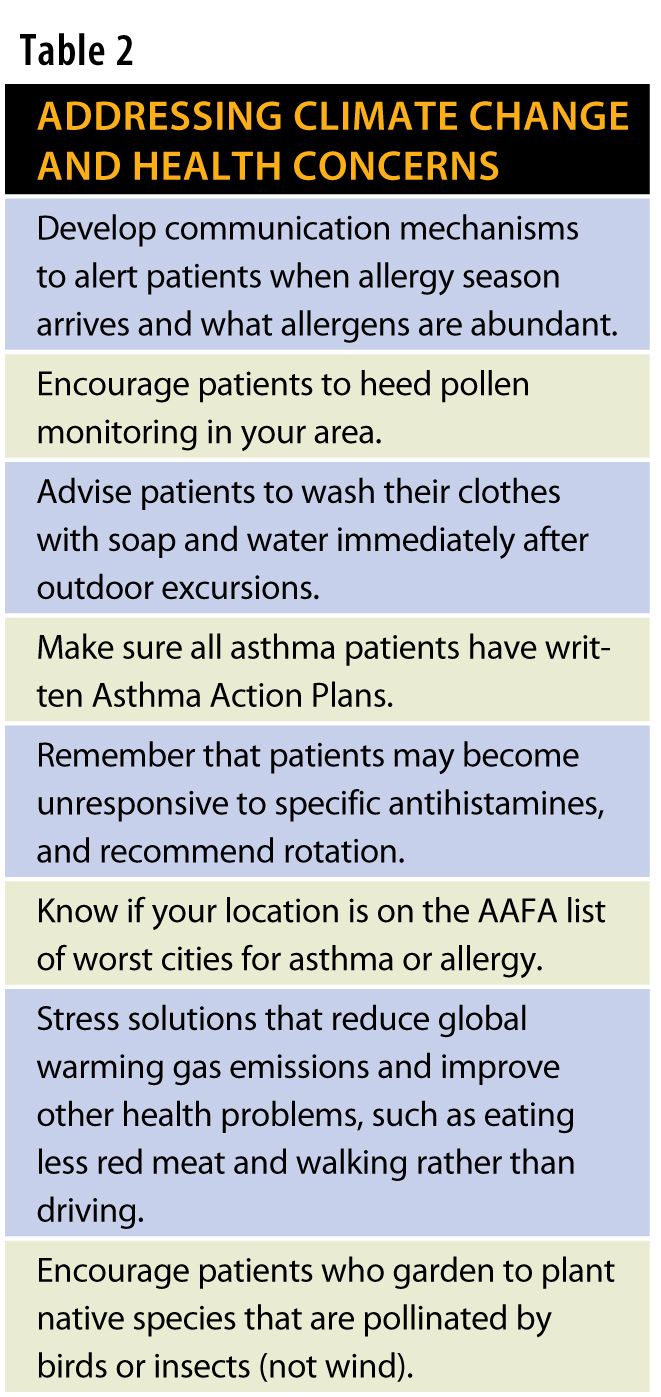Global Warming: Climate Change Impacts Allergy Season
Could changes in weather patterns and the environment have a permanent impact on patient health?
Could changes in weather patterns and the environment have a permanent impact on patient health?
Allergy season has arrived early in many US cities this year. Many people wonder if global warming has influenced spring’s early appearance. Global warming—and its many implications— can be difficult to understand. It’s more than increased temperature and humidity. Other expected changes include heavy rainfall, earlier snowmelt, and more frequent extreme weather events. 1-3 Given the range of expected impact from global warming, scientists and policy makers have begun to use “climate change” as a more encompassing term.
It’s time for health care practitioners to ask, “What health repercussions should we expect from global warming, and how should we prepare?”
To understand the global warming basics, consider weather history. Since 1700, atmospheric greenhouse gas levels have increased more than 40%. 4 Greenhouse gases—including carbon dioxide (CO2 ), methane, nitric oxide—are so-called because they make the earth feel like a greenhouse and plants flourish. The increase hasn’t been steady; it escalated markedly after industrialization. If it continues, CO2 levels will increase fromtheir current level (~386 ppm) to 500 to 1100 ppm in 2100. 2,5
Because CO2 absorbs heat, higher concentrations increase ambient temperatures and humidity, and cause increased air circulation and atmospheric instability. 6 This translates into extreme weather patterns. We can expect more hurricanes, forest fires, floods, and drought—in other words, weather catastrophes. 5,7 Plant phenology (periodic biological phenomena in relation to climate) will also change, but slowly. The health consequences of natural disasters are clear to most people. The consequences of more subtle, insidious weather and health changes may be less evident. 5
Let’s Digress: Allergy And Asthma
Annually, seasonal allergy and asthma are a $30-billion problem in the United States. 8,9 Allergy refers to an Igemediated respiratory disease that causes airway eosinophilia, mucous hypersecretion, and airway hyperresponsiveness when patients are exposed to allergens. 10,11 Patients suffer most when trees bud in the spring, grass sheds pollen in the summer, and ragweed drops its golden cargo in the late summer and autumn. 7,12 More than half of American adults test positive for an allergy to at least 1 seasonal pollen. 13
The number of Americans with asthma—wheezing, breathlessness, chest tightness, and nighttime and early morning coughing—has increased more than 60% since the 1980s. This increasing incidence has been explained by theories such as changing human genetics, increasing exposure to indoor allergens including cockroaches, and a “hygienic” theory that many homes are so clean that children become hypersensitive. Asthma’s steep growth rate, however, suggests other environmental causes. 2 Some facts are alarming. First, exposure to allergens in the first 3 months of life is associated with early wheezing. 10 Among asthmatic American toddlers aged 1 to 3 years, almost half have IgE-mediated sensitivity to seasonal pollen. 14 Other studies have shown similar results in adults. 15
Global Warming And Allergies
Global warming is expected to change climate, air quality, and plant phenology. In fact, some changes have already started (Table 1). In terms of allergy and asthma, our greatest concerns involve increased greenhouse gasses. Because CO2 is the sole energy source for photosynthesis and 95% of plants on earth operate in a CO2 - deficient environment, increasing atmospheric CO2 will help plants thrive.
Envisioning the Garden of Eden? Greenhouse gases won’t differentiate between desirable and undesirable plants. 2,7 With earlier springs, longer growth periods are likely, possibly increasing the length of time humans will be exposed to allergens. 2,6 Three species predicted to be influenced by global warming are particularly bothersome to allergy and asthma sufferers: ragweed, trees, and fungus.

Ragweed
Ragweed, the golden menace that blooms in August and remains through the autumn, causes approximately 75% of hay fever episodes. 4 Each plant carries about 1 billion grains of pollen that, on a windy day, can disperse up to 400 miles. Its main allergy-inducing protein is amb a 1. Under conditions of increased CO2 , ragweed growth accelerates. As the CO2 concentration increases, ragweed’s total protein produced is unchanged, but the plant produces a greater proportion of the amb a 1 protein. 2,4,19
Trees
As temperatures warm, trees favoring cool or cold air will migrate poleward and upward in elevation toward cooler temperatures. 2,6 Climate change seems to favor growth of trees with more allergenic pollen (such as birch, oak, and hickory) than those with little pollen (such as pine, spruce, and fir). 20 In addition, winds and moisture from severe storms cause tree pollen as well as other pollens to burst, creating pollen particles smaller than 4.5 microns—which are much easier to inhale deep into the lungs. 2,6,19
Fungus
Fungus is the least studied of these organisms, but we have extensive knowledge about its behavior. It thrives in warmer, humid environments. Small studies have shown that increasing CO2 concentration can cause up to a 4-fold increase in fungal spore propagation. 7,21 The effect of heat, humidity, and increasing CO2 differs by species. 2
Location, Location, Location
How climate change affects the pollen profile of any locale depends on too many factors to list here. Several trends,

however, are clear:
• Cities, which tend to be warmer than surrounding rural areas, may present problems for asthma and allergy patients.
• Poor air quality is a concern. Ozone, sulphur oxides, nitrogen oxides, and other free radical scavengers that are primary pollutants create a synergistic threat for patients who have asthma and seasonal allergies. They amplify allergen potency and increase the allergen’s ability to penetrate the airway.2,4,7,11
• Pollutants can also make city environments more hospitable to allergens. Ragweed, for example, grows well and produces abundant amb a 1 in polluted cities.4
Acknowledging that where patients live changes their allergy or asthma picture, the Asthma & Allergy Foundation of America (AAFA) annually publishes a list of the top 100 “Asthma Capitals” in the United States. Last year’s top 5 worst cities were Richmond, VA; Knoxville, TN; Memphis, TN; Chattanooga, TN; and Tulsa, OK. The AAFA does the same for “Allergy Capitals”— for spring 2012 these cities top the list: Knoxville, TN; McAllen, TX; Louisville, KY; Jackson, MS; and Wichita, KS.
Implications for Pharmacy
Table 2 shows several actions that pharmacists can take to address real and expected changes.
Conclusion
This article summarizes climate change’s probable effects on allergy and asthma. There are other health effects as well. As global warming’s repercussions continue to manifest, it will be the very young, the very old, the economically disadvantaged, and people who live in climate change “hotspots” who suffer the most.2,4,5
In general, Americans can be classified as alarmed, concerned, cautious, disengaged, or doubtful when it comes to how they think about global warming. Regardless of where they fall on the spectrum, however, approaching the topic from a health perspective increases their interest.1 As educated health care clinicians, pharmacists should look for information that increases their eco-health literacy. Advocating for smart urban planning, increased pollen monitoring, and other mitigating strategies is important, too. PT
Ms. Wick is a visiting professor at the University of Connecticut School of Pharmacy and a freelance writer from Virginia.
References
1. Maibach EW, Nisbet M, Baldwin P, Akerlof K, Diao G. Reframing climate change as a public health issue: an exploratory study of public reactions. BMC Public Health. 2010;10:299.
2. Reid CE, Gamble JL. Aeroallergens, allergic disease, and climate change: impacts and adaptation. Ecohealth. 2009;6:458-470.
3. United States Global Change Research Program. Global climate change impacts in the United States. www.globalchange.gov/publications/reports/scientific-assessments/us-impacts. Published 2009. Accessed March 21, 2012.
4. National Wildlife Federation. Extreme allergies and global warming. www.nwf.org/News-and-Magazines/Media-Center/Reports/Archive/2010/Extreme-Allergies-and-Climate-Change.aspx. Published 2010. Accessed March 21, 2012.
5. Bell E, Horton G, Blashki G, Seidel BM. Climate change: could it help develop ‘adaptive expertise’ [published online ahead of print August 28, 2010]? Adv Health Sci Educ Theory Pract.
6. Meehl GA, Stocker TF, Collins WD, et al. Global climate projections. In: Climate Change 2007: The Physical Science Basis. Solomon S, Qin D, Chen Z, et al, eds. Cambridge, UK: Cambridge University Press; 2007:747-845.
7. Ziska LH, Epstein PR, Schlesinger WH. Rising CO(2), climate change, and public health: exploring the links to plant biology. Environ Health Perspect. 2009;117:155-158.
8. Centers for Disease Prevention and Control. Allergies and hayfever. www.cdc.gov/nchs/fastats/allergies.htm. Accessed March 21, 2012.
9. Klein Walker D. Time to embrace public health approaches to national and global challenges. Am J Public Health. 2008;98:1934-1936.
10. Sheffield PE, Weinberger KR, Kinney PL. Climate change, aeroallergens, and pediatric allergic disease. Mt Sinai J Med. 2011;78:78-84.
11. Dharajiya N, Boldogh I, Cardenas V, Sur S. Role of pollen NAD(P)H oxidase in allergic inflammation. Curr Opin Allergy Clin Immunol. 2008;8:57-62.
12. Ziska L, Knowlton K, Rogers C, et al. Recent warming by latitude associated with increased length of ragweed pollen season in central North America. Proc Natl Acad Sci U S A. 2011;108:4248-4251.
13. Asero R. Birch and ragweed pollinosis north of Milan: a model to investigate the effects of exposure to “new” airborne allergens. Allergy. 2002;57:1063-1066.
14. Ogershok PR, Warner DJ, Hogan MB, Wilson NW. Prevalence of pollen sensitization in younger children who have asthma. Allergy Asthma Proc. 2007;28:654-658.
15. Taylor PE, Jacobson KW, House JM, Glovsky MM. Links between pollen, atopy and the asthma epidemic. Int Arch Allergy Immunol. 2007;144:162-170.
16. Costello A, Abbas M, Allen A, et al. Managing the health effects of climate change: Lancet and University College London Institute for Global Health Commission. Lancet. 2009;373:1693-1733.
17. Solomon S, Qin D, Manning M, et al. Technical Summary, Climate Change 2007: The Physical Science Basis. Contribution of Working Group 1 to the Fourth Assessment Report of the Intergovernmental Panel on Climate Change. Cambridge, UK: Cambridge University Press; 19-91.
18. Beggs PJ. Adaptation to impacts of climate change on aeroallergens and allergic respiratory diseases. Int J Environ Res Public Health. 2010;7:3006-3021.
19. Ahlholm JU, Helander ML, Savolainen J. Genetic and environmental factors affecting the allergenicity of birch pollen. Clin Exp Allergy. 1998;28:1384-1388.
20. Ariano R, Canonica GW, Passalacqua G. Possible role of climate changes in variations in pollen seasons and allergic sensitizations during 27 years. Ann Allergy Asthma Immunol. 2010;104:215-222.
21. Kilronomos JN, Rillig MC, Allen MF, Zak DR, Pregitzer KS, Kubiske ME. Increased levels of airborne fungal spores in response to Populus tremuloides grown under elevated atmospheric CO2. Canadian Journal of Botany. 1997;75:1670-1673.
22. Wick JY. The family antihistamine: all for one and one for all? www.pharmacytimes.com/publications/issue/2011/april2011/The-Family-Antihistamine-0411. Published 2011. Accessed March 22, 2012.

